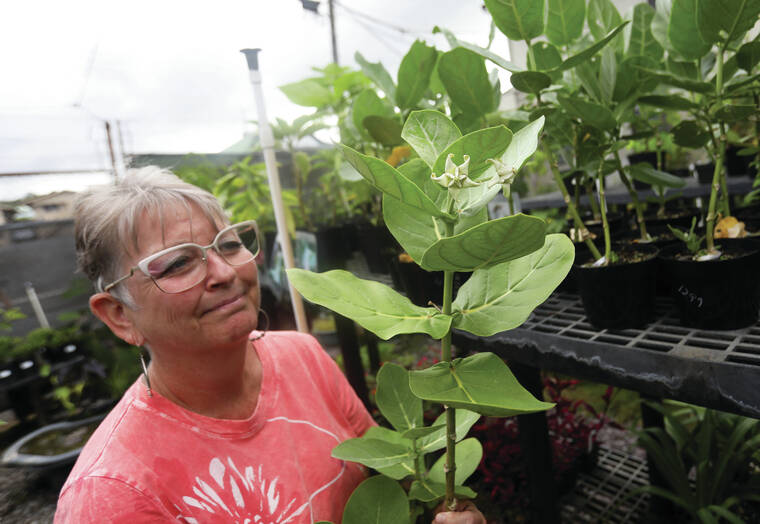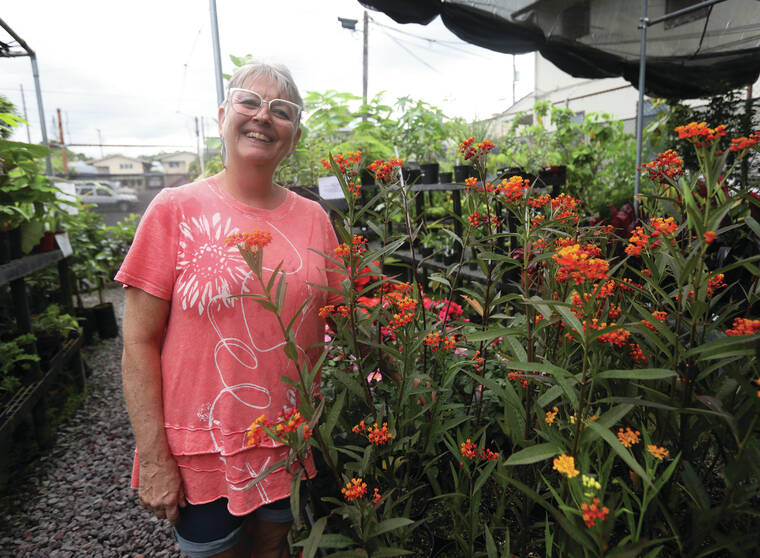‘Once they’re gone, they’re gone’

Garden Exchange owner Tammy Enriquez smiles while looking at a flower from a crown flower plant, which attracts monarch caterpillars and butterflies, as well as native Hawaii insects, on Thursday in Hilo. (Kelsey Walling/Hawaii Tribune-Herald)

Kelsey Walling/Tribune-Herald Garden Exchange owner Tammy Enriquez stands by tropical milkweeds that are used to attract monarch caterpillars and butterflies, as well as insects native to Hawaii, on Thursday in Hilo.
A call to action from the environmental community has been sent out to help save the migrating monarch butterfly. But in Hawaii, a variety of other endemic insects are threatened or endangered and could benefit from home gardeners planting flora native to Hawaii
A call to action from the environmental community has been sent out to help save the migrating monarch butterfly. But in Hawaii, a variety of other endemic insects are threatened or endangered and could benefit from home gardeners planting flora native to Hawaii
The monarch is not native to the islands, with many speculating it arrived with its host plants, the tropical milkweed and the crown flower.
“The idea is they came in the mid-1800s,” said Daniel Babbit, program specialist at Honolulu Botanical Gardens. “They most likely came along with tropical milkweed when it was first brought to the islands, and again when crown flowers came in the late 1800s.”
The monarch’s ability to fly distances up to 3,000 miles has led to its presence in Colombia, the tropics in South America, central America and even Canada.
But environmental factors like habitat loss, climate change and the use of pesticides and herbicides have contributed to the monarch’s addition to the “red list” of threatened species, just two steps away from extinction, according to the International Union for the Conservation of Nature.
But here in Hawaii, the butterfly is thriving.
“I don’t think people in Hawaii should worry about monarch butterflies. They’re doing fine here,” said Daniel Rubinoff, professor of entomology at the University of Hawaii at Manoa “The monarch is getting tons and tons of help in the places where it’s native, and yet in places like this, there’s so many other insects that aren’t getting the help they need, and they’re only found here. They are our special insects.”
There are two other butterflies that are native to Hawaii Island: the Kamehameha butterfly, which has a similar color scheme as the monarch, and the Hawaiian Blue butterfly, which is actually green.
There are 18 other butterflies that can be found on the island, as well and over 955 native species of moths.
“Neither of those are in danger technically, but they’re very scarce, and the populations are sparse,” said Babbit of the two Big Island butterflies. “What you can do is plant a well-rounded pollinator garden.”
Planting pollinator gardens also can help attract a variety of native bees.
“The monarch butterfly is a pollinator, and pollinators are extremely important,” said Babbit. “A third of the food supply is based on pollinator plants.”
Rubinoff said planting native flora is helpful when it comes to saving and preserving biodiversity, which can help sustain populations of native bugs and insects unique to Hawaii.
“There are hundreds of species of native Hawaiian insects that are endangered, and there’s a handful of them that have been listed already, including some native bees, some native fruit flies and damselflies, but the list is much, much bigger than that,” he said.
Endangered insects native to Hawaii in need of protection include the Blackburn’s Sphinx Moth, the Crimson Hawaiian Damselfy, the Pomance Fly and Schauinslan’s Bush Cricket. A full list of endangered insects from the state can be viewed here: https://tinyurl.com/2p86yypt.
“The easy thing that anybody could do to help would be not to plant or introduce species of plants, and instead to try and plant native Hawaiian plants in their yards,” said Rubinoff. “One of the main challenges for the native insects now is that their habitat is disappearing. That’s because introduced plants are taking over the forests and wiping out what our native insects need.”
Hawaii’s native butterflies and insects are attracted by the same host plants as the monarchs, like the tropical milkweed and the crown flower, both of which can be purchased locally at Garden Exchange in Hilo.
“They fly out of the store every day,” said Garden Exchange owner Tammy Enriquez of the butterflies. “And I have caterpillars in the store, I have the chrysalis in the store, so the kids get to see them lay the eggs right there on the plant.”
Enriquez noted that her supplier of the milkweed and crown flower plants has to spray them prior to bringing them to the store, so the best course of action is to wash down the plants after purchasing, and allowing them to wait a week before placing the plants outside and into gardens for caterpillars and butterflies to feed.
“We also sell some flower seeds that’s a mix specifically for butterflies,” said Enriquez, who encourages curious customers to come in and ask any questions about what’s best to plant in gardens to attract butterflies or other native insects.
Other plants that Rubinoff recommends for the Hilo environment include koa, ohia, kopiko, ‘a‘ali‘i, mamaki and ‘oha wai.
“There’s more diversity per square mile here than there is anywhere on the mainland,” said Rubinoff. “We have this opportunity that few other people have to save and help native biodiversity that is unique to our place. That really seems like where people here should be focusing their energy.”
Butterflies are poisonous to eat for many animals, which protects them from predators, although they are vulnerable to parasites and pesticides.
“It’s mostly parasites and wasps that are going to be attacking them,” said Babbit. “They are poisonous to eat, so when a bird eats them, they have mimetic reaction and it makes them throw up, so they’re not too tasty.”
While the threat to monarchs is real, Rubinoff hopes we can focus on our local environment first.
“If the Monarch were to disappear from Hawaii, if we kept the crown flower around, it would find its way back here. But these other insects that are found nowhere else, once they’re gone, they’re gone,” he said. “Every time somebody hears about Monarchs needing help on the mainland, they should think of our native insects and native butterflies and try to help them instead.”
Email Grant Phillips at gphillips@hawaiitribune-herald.com.


